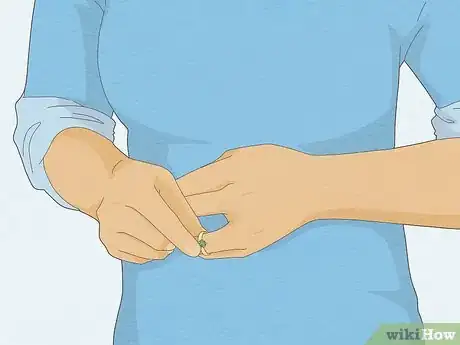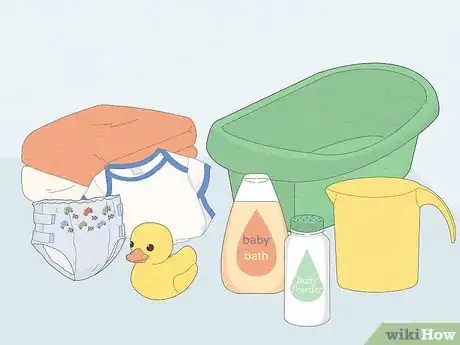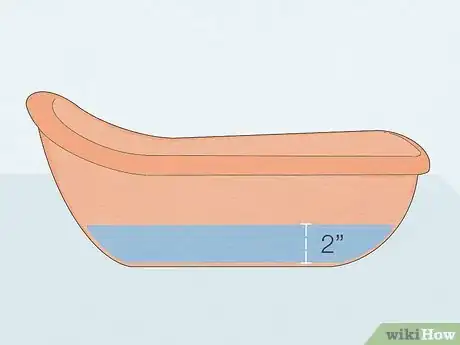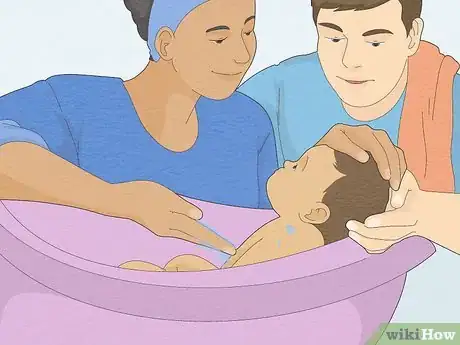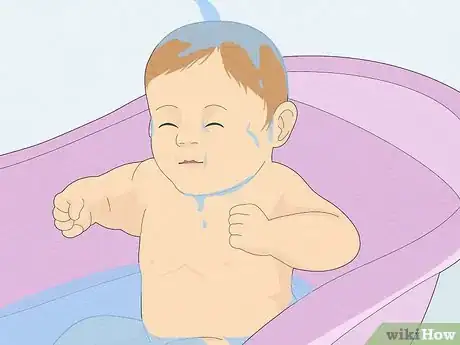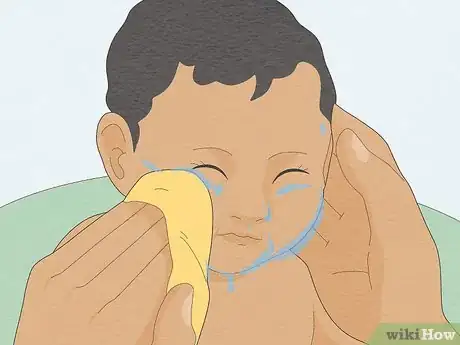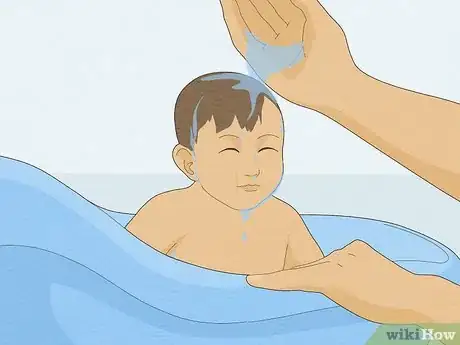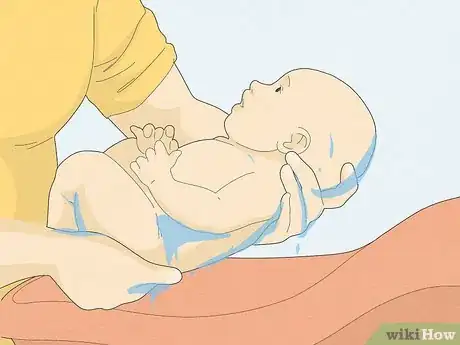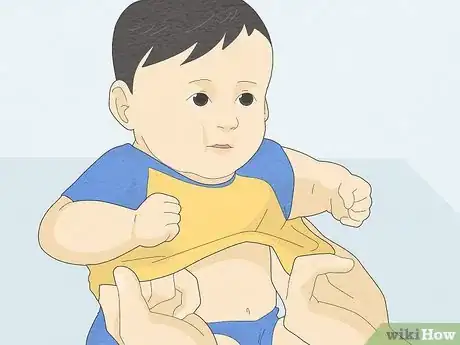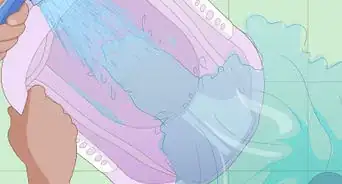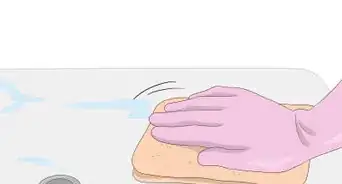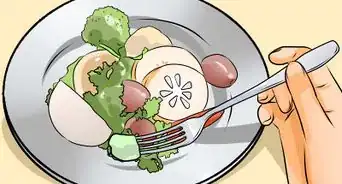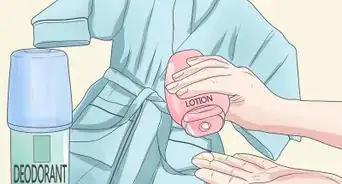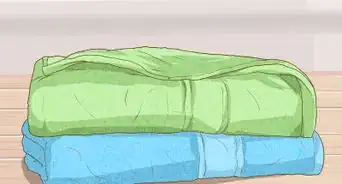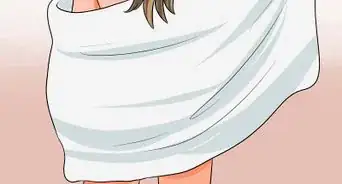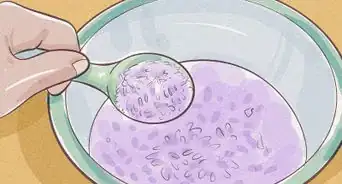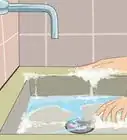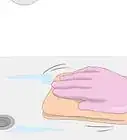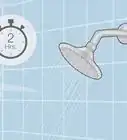This article was co-authored by Giselle Baumet. Giselle Baumet is a Mindset & Wellness Coach and the Owner of Granola Babies based in Orange County, California. With more than 16 years of experience, she specializes in helping others, particularly parents, navigate through life’s challenges. Giselle earned a BS from Rhode Island College and a Lactation Educator Certification from The University of San Diego. She also holds a Women’s Life Coach Certification from The Academy of Creative Coaching, a Transpersonal Hypnotherapist and Somatic Healer Certification from The Transpersonal Hypnotherapy Institute, a Hypnosis and Childbirth Certification from The American Hypnosis Association, and a Positive Parenting Educator Certification from Positive Discipline.
There are 8 references cited in this article, which can be found at the bottom of the page.
wikiHow marks an article as reader-approved once it receives enough positive feedback. In this case, 100% of readers who voted found the article helpful, earning it our reader-approved status.
This article has been viewed 108,371 times.
Giving your baby a bath is a great way to bond with your child and to make sure he or she is clean and cared for. A regular bath may help prevent "Cradle Cap" also. The most important thing is to make sure you never leave your baby unattended. Other than that, you have to get all of your materials in order and get ready to safely and carefully clean your child.
Steps
Preparing to Bathe Your Baby
-
1Wear appropriate clothing. Roll up your long sleeves, remove your jewelry, and take off any other items, such as watches, that may get in your way. Know that bathing a baby can be a wet operation and be prepared to find a change of clothes afterward. You want to wear something you don't care about so you can properly bathe your baby.
-
2Get all of your supplies in order. Once the baby's in the bath, you won't be able to leave his side, not even for a second, so it's important to get all of the materials you need together. If you do forget something and are bathing your baby alone, then you'll have to take him with you to retrieve it.[1] Here's what you'll need to bathe your baby:
- A baby bathtub[2]
- A soft towel with a hood (or soft muslin blankets to use as towels)[3]
- Extra towels just in case
- Cotton wool balls, a washcloth or a sponge for washing your baby
- A pitcher for pouring water over your baby
- Baby soap[4]
- Baby shampoo (if you choose to use it)
- A changing mat
- A change of clothes
- A clean diaper
- Baby powder
- Bath toys (optional)
- Bubble bath (optional)
- A tub for your baby if it's small or a newborn
Advertisement -
3Fill the tub with about 2 inches (5 cm) of warm water. You don't want the tub to be filled any more than that, and even then, you should always watch your baby since they could still drown in less than 2 inches (5 cm) of water when left unattended.[5] Before you put your baby in the water, you should test it on the underside of your wrist or dip your elbow in to make sure it's warm to lukewarm and that there's no way your baby can be burned by it.[6]
- The ideal temperature should be around 90ºF (32ºC).
- Don't ever place your baby in the tub while the water's still running. This can lead the water to get too deep or too hot.
- If your baby is newborn or very small, you should use a baby holder or a plastic tub for your baby.[7] You can even wash your baby in the sink, which will make the process easier if the sink is large enough.
- If you want to make bath time more fun, then you can add a few bath toys and bubble bath into the water before you place your baby in it. Just don't overdo it on the bubble bath or your baby may get overwhelmed.
- Consider closing the bathroom door when you give your baby a bath. You don't want him to feel chilly once you take him out of the tub.
-
4Consider getting some help. Though you are perfectly capable of bathing your baby on your own, you should consider getting some help, whether it's from the other parent, one of the child's grandparents, or a friend. Just having another person there to guide you can help you feel reassured if it's your first time and can make the process feel less overwhelming.
- But if you have to do it on your own, there's no need to worry and you'll do a great job no matter what.
-
5Undress your baby. Remove your baby's clothes as well as his diaper. This should be the last thing you do before you bathe your baby. You don't want to undress your baby first, or he may be getting cold as you prepare the tub.[8]
- If you find that your baby cries through every bath, then you should start bathing your baby with its diaper on. This can give it an added sense of security until it gets more comfortable in the water.
- Of course, you should make sure your baby is ready for a bath before you begin bathing it. You should wait for the umbilical stump to completely fall off and heal before you bathe your baby. Before that, cleaning your baby carefully with a wet cloth will do.[9]
-
6Remember that you should never leave your child unattended. This is absolutely the most important part of giving your baby a bath. Know that a child can drown in less than 1 inch (2.5 cm) of water. There's absolutely nothing in the world that should make you leave your child in the tub by himself, not even for a second.[10]
- If you've forgotten something necessary for bathing your child, then you'll have to either leave it or take your baby with you to retrieve it.
Bathing Your Baby
-
1Slowly ease your baby into the tub feet first. You should use one hand to support the baby's head and neck. Slowly ease the baby into the water, whether you're using the sink, a bathtub, or a small plastic tub for your baby.[11] [12] Make sure your baby is relaxed and comfortable.
- Prepare for some tears. Not all babies like the feeling of being lowered into water, especially not at first. Others, however, love the water right away!
-
2Gently pour cupfuls of water over your baby. Use a pitcher, or your hand, to carefully pour cupfuls of water onto your baby's body and over its head. Make sure to wet your child's skin and hair completely. Just don't get water in your baby's eyes or pour water all over its face quickly, or it will get upset. You want your baby to be completely wet before you start using soap.
- Just know that babies will be more slippery when they're wet. Prepare to handle your baby with extra care once you've lowered it into the water.
-
3Wash your baby with soap. Make sure you use a mild, tear-free baby soap that won't irritate your baby's skin. Though some people like to use baby shampoo for their baby's hair, it's perfectly fine to use regular soap on your baby's head; many people prefer this because it won't dry out your baby's scalp.[13] Here's how you wash your baby:
- Use your hand or a gentle washcloth and wash your baby from top to bottom both on its front and back.
- Wash the baby's scalp with a soapy and wet cloth. If you'd like to use shampoo, you can do that, but it's really not necessary. To use shampoo, just pour a dime-sized amount of tear free shampoo onto your hands, lather the shampoo into your hands and then massage your baby's scalp with it.
- Gently clean your baby's eyes and face with a cloth that is free of soap. You don't want to get soap in your baby's eyes.
- Give your baby's genitals a regular washing. There's no need to be extra thorough.
- If any mucus is stuck around your baby's nose or eyes, dab at it a few times before wiping it off.
-
4Rinse your child. Once you've washed your baby with soap, you can wash your baby with the bathwater. Either pour clean water over your baby with your hands, or use a pitcher to pour water over your child to rinse all of the soap off. Make sure to do this slowly and gently so your baby doesn't get too startled or overwhelmed.
- If it's safely possible, tilt the child's head back to avoid the eyes and pour cupfuls of water over their hair until it is soap free.
-
5Take your child out of the tub. Take your child out of the tub and place it in a soft, warm towel.[14] As you do this, place one hand under her neck and the other under her bottom. If the towel has a hood, then that's even better.[15] Be careful with your baby when it's wet. Make sure that you've washed off all of the soap.
- The whole bath should only take about five minutes. You don't want your baby in there too long or the water will get cold. Plus, a short bath is perfect for babies who don't like the water.
-
6Pat your baby dry. Make sure to thoroughly pat your baby's body and hair dry as gently as you can. If your baby's skin is still peeling from birth, just use a bit of lotion on her if you want to, but know that this skin will come off anyway.
- Rub lotion, baby powder, or diaper cream onto your baby's body if that's what you normally do. Just make sure your baby is dry first.
-
7Dress your baby. Now that your baby is nice and clean, all you have to do is dress him. Place your diaper on your baby along with its clothes, and your baby should be nice and clean and ready for naptime—or for whatever the day may hold.[16]
Expert Q&A
-
QuestionWhen should you give a baby a bath?
 Giselle BaumetGiselle Baumet is a Mindset & Wellness Coach and the Owner of Granola Babies based in Orange County, California. With more than 16 years of experience, she specializes in helping others, particularly parents, navigate through life’s challenges. Giselle earned a BS from Rhode Island College and a Lactation Educator Certification from The University of San Diego. She also holds a Women’s Life Coach Certification from The Academy of Creative Coaching, a Transpersonal Hypnotherapist and Somatic Healer Certification from The Transpersonal Hypnotherapy Institute, a Hypnosis and Childbirth Certification from The American Hypnosis Association, and a Positive Parenting Educator Certification from Positive Discipline.
Giselle BaumetGiselle Baumet is a Mindset & Wellness Coach and the Owner of Granola Babies based in Orange County, California. With more than 16 years of experience, she specializes in helping others, particularly parents, navigate through life’s challenges. Giselle earned a BS from Rhode Island College and a Lactation Educator Certification from The University of San Diego. She also holds a Women’s Life Coach Certification from The Academy of Creative Coaching, a Transpersonal Hypnotherapist and Somatic Healer Certification from The Transpersonal Hypnotherapy Institute, a Hypnosis and Childbirth Certification from The American Hypnosis Association, and a Positive Parenting Educator Certification from Positive Discipline.
Mindset & Wellness Coach Plan your baby's bath a few minutes after feeding and at a time when you can be calm and relaxed throughout the process. Pay attention to your baby's cues, too—if they seem fussy, stop the bath and try again another time.
Plan your baby's bath a few minutes after feeding and at a time when you can be calm and relaxed throughout the process. Pay attention to your baby's cues, too—if they seem fussy, stop the bath and try again another time. -
QuestionHow do you comfort a baby in the bathtub?
 Giselle BaumetGiselle Baumet is a Mindset & Wellness Coach and the Owner of Granola Babies based in Orange County, California. With more than 16 years of experience, she specializes in helping others, particularly parents, navigate through life’s challenges. Giselle earned a BS from Rhode Island College and a Lactation Educator Certification from The University of San Diego. She also holds a Women’s Life Coach Certification from The Academy of Creative Coaching, a Transpersonal Hypnotherapist and Somatic Healer Certification from The Transpersonal Hypnotherapy Institute, a Hypnosis and Childbirth Certification from The American Hypnosis Association, and a Positive Parenting Educator Certification from Positive Discipline.
Giselle BaumetGiselle Baumet is a Mindset & Wellness Coach and the Owner of Granola Babies based in Orange County, California. With more than 16 years of experience, she specializes in helping others, particularly parents, navigate through life’s challenges. Giselle earned a BS from Rhode Island College and a Lactation Educator Certification from The University of San Diego. She also holds a Women’s Life Coach Certification from The Academy of Creative Coaching, a Transpersonal Hypnotherapist and Somatic Healer Certification from The Transpersonal Hypnotherapy Institute, a Hypnosis and Childbirth Certification from The American Hypnosis Association, and a Positive Parenting Educator Certification from Positive Discipline.
Mindset & Wellness Coach Keep a hand on the baby throughout the bath. Your touch is very comforting to the child!
Keep a hand on the baby throughout the bath. Your touch is very comforting to the child! -
QuestionCan I bath more than one baby at a time or can I only bath one at a time?
 Community AnswerIt is safest to bath one at a time. However, if you have the help of another person it should be okay.
Community AnswerIt is safest to bath one at a time. However, if you have the help of another person it should be okay.
Warnings
- Some soaps, shampoos, bubble baths, and lotion can irritate sensitive skin.⧼thumbs_response⧽
- Do not, especially if giving the bath in the kitchen area, leave plugged in appliance near the bathing child.⧼thumbs_response⧽
Things You'll Need
- Towel
- Tear free shampoo
- Children's body wash or soap
- Lotion
- Cup
- Washcloth
- Toys
- Clothing (optional)
References
- ↑ https://www.thebump.com/a/what-to-know-about-baby-s-first-bath
- ↑ Giselle Baumet. Mindset & Wellness Coach. Expert Interview. 13 December 2021.
- ↑ Giselle Baumet. Mindset & Wellness Coach. Expert Interview. 13 December 2021.
- ↑ Giselle Baumet. Mindset & Wellness Coach. Expert Interview. 13 December 2021.
- ↑ https://kidshealth.org/en/parents/water-safety.html
- ↑ https://www.parents.com/baby/care/bath/how-to-give-baby-a-bath/
- ↑ https://www.thebump.com/a/what-to-know-about-baby-s-first-bath
- ↑ https://www.healthychildren.org/English/ages-stages/baby/bathing-skin-care/Pages/Bathing-Your-Newborn.aspx
- ↑ https://www.webmd.com/parenting/baby/bathing-newborn#1
- ↑ https://www.webmd.com/parenting/baby/bathing-newborn#1
- ↑ https://www.healthychildren.org/English/ages-stages/baby/bathing-skin-care/Pages/Bathing-Your-Newborn.aspx
- ↑ Giselle Baumet. Mindset & Wellness Coach. Expert Interview. 13 December 2021.
- ↑ https://www.parents.com/baby/care/bath/how-to-give-baby-a-bath/
- ↑ Giselle Baumet. Mindset & Wellness Coach. Expert Interview. 13 December 2021.
- ↑ https://raisingchildren.net.au/newborns/health-daily-care/hygiene-keeping-clean/bathing-a-newborn
- ↑ https://raisingchildren.net.au/newborns/health-daily-care/hygiene-keeping-clean/bathing-a-newborn
- http://www.babycenter.com/0_bathing-your-newborn_1198068.bc
About This Article
Before you give a baby a bath, gather all of your supplies, like a towel, a pitcher, soap, and a clean diaper. After your baby is in the bath, you will not be able to leave them unattended. Once you have your supplies, start running warm water and fill the tub to about 3 inches deep. Be sure to test the water with your elbow to make sure it isn't too hot. Gently place the baby in the tub and use the pitcher to pour water over their body. Wash them all over with a gentle soap and then rinse them using the pitcher. Once they are rinsed, pull them out of the tub, support their neck and bottom, and wrap them in a soft towel. To learn how to make bath time more fun for your baby, keep reading.
